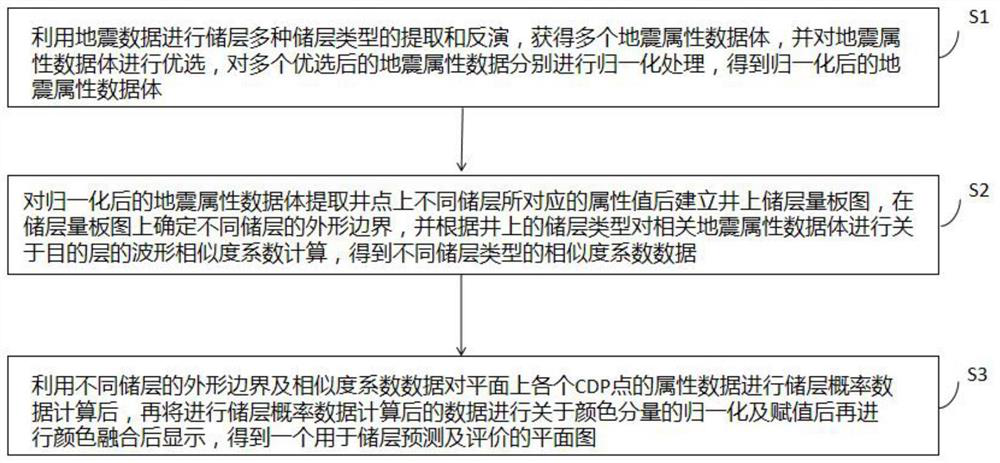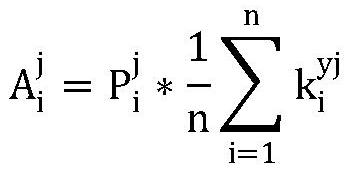Method and system for predicting plane distribution of different reservoirs
A plane distribution and reservoir technology, applied in the field of geophysical exploration, can solve the problem of inability to accurately predict and distinguish different types of reservoirs, reservoirs and non-reservoirs, etc., achieve accurate and reliable prediction and distinction results, and use less materials , the effect of structural stability
- Summary
- Abstract
- Description
- Claims
- Application Information
AI Technical Summary
Problems solved by technology
Method used
Image
Examples
Embodiment 1
[0049] Such as figure 1 As shown, a method for predicting the plane distribution of different reservoirs includes the following steps:
[0050] S1, using seismic data to extract and invert various types of reservoirs, obtain multiple seismic attribute data volumes, optimize the seismic attribute data volumes, and normalize the multiple optimized seismic attribute data processing to obtain the normalized seismic attribute data volume;
[0051] S2. After extracting the attribute values corresponding to different reservoirs on the well point from the normalized seismic attribute data volume, the above-ground reservoir volume map is established, and the shape boundaries of different reservoirs are determined on the reservoir volume map, and according to The type of reservoir on the well is to calculate the waveform similarity coefficient of the target layer on the relevant seismic attribute data body, and obtain the similarity coefficient data of different reservoir types;
[...
Embodiment 2
[0112] Such as figure 1 As shown, a system for predicting the plane distribution of different reservoirs includes the following modules:
[0113] Normalization module: used to extract and invert various reservoir types using seismic data, obtain multiple seismic attribute data volumes, optimize seismic attribute data volumes, and optimize multiple seismic attribute data volumes Perform normalization processing respectively to obtain the normalized seismic attribute data volume;
[0114] Similarity coefficient generation module: it is used to extract the attribute values corresponding to different reservoirs on the well point from the normalized seismic attribute data volume, and then establish the reservoir volume map on the well, and determine the different reservoirs on the reservoir volume map According to the reservoir type on the well, the waveform similarity coefficient of the target layer is calculated for the relevant seismic attribute data body, and the similarity ...
Embodiment 3
[0119] Such as figure 1 As shown, the work steps are formulated. This embodiment is to predict the deep shale gas reservoir of the Longmaxi Formation in marine facies in a shale gas exploration area in Sichuan.
[0120] Extract three types of attribute data related to porosity, fractures and reservoir productivity. According to the actual situation of the project time and computer computing power in this area, expert experience and relatively mature geophysical technology, use 3D pre-stack gathers and The post-stack seismic data are calculated separately for the porosity data volume, P-wave anisotropy data volume, and Poisson's ratio data volume, representing three types of porosity, fractures, and reservoir productivity. Using 3D post-stack seismic data, well logging data and geological stratification data of each well, the calibration of the target shale interval in this area and the interpretation of the relevant top and bottom positions are completed, and the horizon data ...
PUM
 Login to View More
Login to View More Abstract
Description
Claims
Application Information
 Login to View More
Login to View More - R&D
- Intellectual Property
- Life Sciences
- Materials
- Tech Scout
- Unparalleled Data Quality
- Higher Quality Content
- 60% Fewer Hallucinations
Browse by: Latest US Patents, China's latest patents, Technical Efficacy Thesaurus, Application Domain, Technology Topic, Popular Technical Reports.
© 2025 PatSnap. All rights reserved.Legal|Privacy policy|Modern Slavery Act Transparency Statement|Sitemap|About US| Contact US: help@patsnap.com



